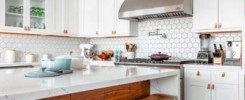Hi again Everybody, Chris Town here, owner of Town Construction and Development and here once again with some cool home interior painting tips for you. If I can help you save some time, save a buck or two like me, hopefully, you will enjoy what most homeowners love to do is to choosing colors and painting their bathrooms, kitchens, and bedrooms. Something the whole family can participate in for sure.
So here are some helpful tips to get you started. Some ideas you probably know about already and some you may not be aware of.
Walking into a paint store or department store can be overwhelming and cost big bucks if your not careful, but it doesn’t have to be that way especially if your starting from scratch.
Please always keep in mind, buying the most expensive tools and paints is your choice, but from my experience it can be a waste of money.
Best brands don’t equal best choices!
BRUSHES AND PAINT ROLLERS
Even if you have the best quality paint, using the wrong roller or brush for your project can waste time and money. Picking the right tools, your paint job is going to get the most payback for your investment and make the process much more enjoyable and rewarding.

Paint Brushes:
Natural-hair bristles are best used with oil-based paints, stains and varnishes while Synthetic bristles are better with water-based and latex paints.
When you’re buying any paintbrush, there are a few things to look out for:
1: Tug on the bristles. If one or two bristles can be pulled out, the brush is probably poorly made (a piece of junk) and the bristles will pull out during your painting application.
2: Hold the brush by the handle. Choose a brush that feels comfortable in your hand.
3: Note the type of bristle tips. Flagged bristles, or split ends, hold more paint, while tipped brushes are favored by pros for their precision and control.

Paint Rollers:
The thickness of roller covers is called the nap or pile. A rule of thumb holds that the rougher the painting surface, the thicker the nap you should use.
When you’re shopping for rollers is the length of the nap, or the material that makes up the roller cover. Generally speaking, you should paint smooth surfaces with a short nap, and rougher surfaces—like stucco, brick and masonry—with longer nap so those fibers really get the paint into every nook and cranny with a longer nap.
1/8 ” – 1/4” naps are best for wallboard, smooth plaster, wood or metal
3/8” – 3/4” naps are best for light-textured stucco, poured concrete and rough wood
3/4” – 1” naps are best for heavy-textured stucco, concrete block and brick
Gloss and semi-gloss paints (mostly used for Bathrooms and Kitchens) go on better with short-nap rollers because these tend to generate a smoother finish when you’re rolling the paint out. So a 1/8 ” – 1/4” naps are best. I would stay with 1/8 ” nap.
(Some info courtesy of duckbrand)
How to Choose an Interior Paint Finish:
Choosing a paint finish for interior walls depends on the desired amount of shine and durability. The most common interior paint finishes (paint sheen) are flat, eggshell, satin, semi-gloss, and high-gloss. Choosing the right paint finish for your interior project depends on the look, durability, and ambiance you want.
Flat finish:
Available only in latex paint, a flat finish. It works great on interior walls and ceilings. As the least shiny finish available, it doesn’t clean well and isn’t suited for kitchens and bathrooms.
Eggshell finish: An eggshell finish is often used for decorative finishes because it provides a low luster. It cleans up better than a flat finish, but probably not as well as you would want in a kitchen or bathroom.
Satin finish:
The most popular paint sheen is a satin finish. It has more sheen than eggshell or satin and cleans better too. This finish is a good choice for woodwork, walls, doors, and hallways. It’s also great for bedrooms and dining rooms. Satin is washable but it isn’t scrubbable, so you probably don’t want to use it around your toddler’s craft table.
Semi-gloss finish:
A semi-gloss paint will give your room a subtle shine. It’s scrubbable and good for moldings, doors, windows, kitchens, and baths.
High-gloss finish:
A high-gloss finish has a shiny, polished look. It’s also stain resistant and very scrubbable, which makes it a good choice for the areas of a home that get the most wear and tear, such as kitchens and baths. Food splatter or even crayon marks will clean up easily on a high-gloss finish.
(Some info courtesy of dummies.com)
“Town Tips” by Chris Town
Edging tools are the perfect paint edger for quick projects. First, it’s designed to easily snap onto a standard 3-inch paintbrush. This design also permits quick cleanup and is remarkably effective at achieving clean edges around trim, baseboards, and other tricky paint jobs.
Shur-Line 1000C Paint Premium Edger: Best for your budget – around $3.99
The Shur-Line 1000C premium paint edger is very low cost and simple to use. Although designed mainly for manual use, it can be attached to a threaded extension pole for those hard-to-reach paint jobs.
All solutions for home living have some advantages and disadvantages…
“There are no perfect solutions out there, only the ones that are perfect for you.”
Chris Town/



